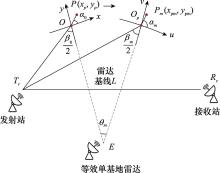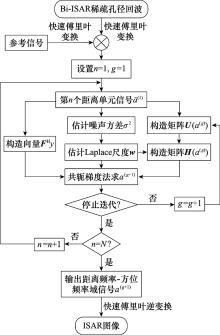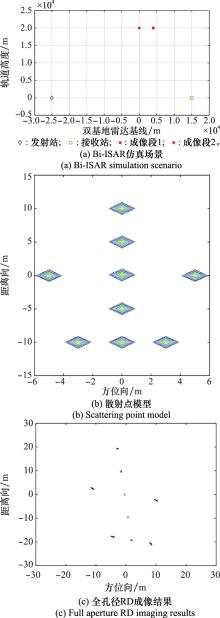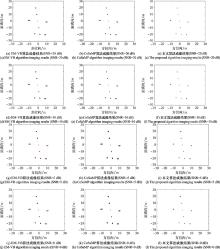Systems Engineering and Electronics ›› 2023, Vol. 45 ›› Issue (7): 2022-2030.doi: 10.12305/j.issn.1001-506X.2023.07.12
• Sensors and Signal Processing • Previous Articles Next Articles
Bistatic ISAR sparse aperture maneuvering target MTRC compensation imaging algorithm
Hanshen ZHU1, Wenhua HU1,*, Baofeng GUO1, Liting JIAO1, Xiaoxiu ZHU2, Chang'an ZHU1
- 1. Department of Electronic and Optical Engineering, Shijiazhuang Campus, Army Engineering University, Shijiazhuang 050003, China
2. Unit 32398 of the PLA, Beijing 100192, China
-
Received:2022-03-11Online:2023-06-30Published:2023-07-11 -
Contact:Wenhua HU
CLC Number:
Cite this article
Hanshen ZHU, Wenhua HU, Baofeng GUO, Liting JIAO, Xiaoxiu ZHU, Chang'an ZHU. Bistatic ISAR sparse aperture maneuvering target MTRC compensation imaging algorithm[J]. Systems Engineering and Electronics, 2023, 45(7): 2022-2030.
share this article
Table 2
Comparison of imaging indexes of algorithm under different SNR"
| 衡量指标 | 算法 | SNR/dB | |||
| 20 | 10 | 5 | 0 | ||
| 图像熵 | EM-VB | 2.874 5 | 2.901 4 | 2.952 4 | 3.052 4 |
| CoSaMP | 2.327 1 | 2.572 4 | 2.677 5 | 2.895 2 | |
| 本文算法 | 2.012 4 | 2.195 7 | 2.342 4 | 2.467 5 | |
| TBR | EM-VB | 12.349 | 11.427 5 | 10.106 5 | 9.562 4 |
| CoSaMP | 24.795 1 | 21.224 7 | 18.032 6 | 12.774 5 | |
| 本文算法 | 29.336 5 | 26.716 3 | 23.425 7 | 20.454 5 | |
| 1 |
ZHANG S S , ZHANG W , ZONG Z L , et al. High-resolution bistatic ISAR imaging based on two-dimensional compressed sensing[J]. IEEE Trans.on Antennas and Propagation, 2015, 63 (5): 2098- 2111.
doi: 10.1109/TAP.2015.2408337 |
| 2 | KANG M S , LEE S H , KIM K T , et al. Bistatic ISAR imaging and scaling of highly maneuvering target with complex motion via compressive sensing[J]. IEEE Trans.on Aerospace and Electronic Systems, 2016, 54 (6): 2809- 2826. |
| 3 |
KANG B S , RYU B H , KIM K T . Bistatic ISAR imaging for non-uniformly rotating targets[J]. IEEE Trans.on Aerospace and Electronic Systems, 2019, 55 (4): 1972- 1988.
doi: 10.1109/TAES.2018.2880027 |
| 4 | 朱晓秀, 胡文华, 郭宝锋, 等. 基于快速SBL的双基地ISAR成像[J]. 雷达科学与技术, 2019, 17 (3): 290- 298. |
| ZHU X X , HU W H , GUO B F , et al. Bistatic ISAR imaging based on fast SBL algorithm with sparse aperture[J]. Radar Science and Technology, 2019, 17 (3): 290- 298. | |
| 5 | SHI L , ZHU X X , SHANG C X , et al. High-resolution bistatic ISAR imaging of a space target with sparse aperture[J]. Electronics, 2017, 8 (8): 874- 893. |
| 6 |
陈文峰, 陈阿磊, 郑岱堃, 等. 参数化稀疏表示的双基地ISAR机动目标成像方法[J]. 空军预警学院学报, 2020, 34 (3): 157- 162.
doi: 10.3969/j.issn.2095-5839.2020.03.001 |
|
CHEN W F , CHEN A L , ZHENG D K , et al. Bistatic ISAR maneuvering target imaging method based on parameterized sparse representation[J]. Journal of Air Force Early Warning Academy, 2020, 34 (3): 157- 162.
doi: 10.3969/j.issn.2095-5839.2020.03.001 |
|
| 7 | QIAN J , HUANG S Y , WANG L , et al. Super-resolution ISAR imaging for maneuvering target based on deep learning assisted time-frequency analysis[J]. IEEE Trans.on Geoscience and Remote Sensing, 2021, 99, 1- 14. |
| 8 |
PERRY R P , DIPIETRO R C , FANTE R L . SAR imaging of moving targets[J]. IEEE Trans.on Aerospace and Electronic Systems, 1999, 35 (1): 188- 200.
doi: 10.1109/7.745691 |
| 9 |
ZHANG S H , LIU Y X , LI X . Sparse aperture InISAR imaging via sequential multiple sparse Bayesian learning[J]. Sensors, 2017, 17 (10): 2295- 2315.
doi: 10.3390/s17102295 |
| 10 | ZENG C Z , ZHU W G , JIA X , et al. Sparse aperture ISAR imaging method based on joint constraints of sparsity and low rank[J]. IEEE Trans.on Geoscience and Remote Sensing, 2020, 59 (1): 168- 181. |
| 11 |
ZHANG S H , LIU Y X , LI X . Autofocusing for sparse aperture ISAR imaging based on joint constraint of sparsity and minimum rntropy[J]. IEEE Journal of Selected Topics in Applied Earth Observations and Remote Sensing, 2017, 10 (3): 998- 1011.
doi: 10.1109/JSTARS.2016.2598880 |
| 12 | CHEN W F , LV M J , YANG J , et al. Sparse aperture bistatic ISAR imaging under low signal-to-noise ratio condition[J]. Journal of Applied Remote Sensing, 2020, 14 (3): 1- 15. |
| 13 |
DONOHO D L . Compressed sensing[J]. IEEE Trans.on Information Theory, 2006, 52 (4): 1289- 1306.
doi: 10.1109/TIT.2006.871582 |
| 14 |
朱小鹏, 张群, 朱仁飞, 等. 双站ISAR越距离单元徙动分析与校正算法[J]. 系统工程与电子技术, 2010, 32 (9): 1828- 1832.
doi: 10.3969/j.issn.1001-506X.2010.09.09 |
|
ZHU X P , ZHANG Q , ZHU R F , et al. Study on correction algorithm of migration through resolution cell in bistatic-ISAR[J]. Systems Engineering and Electronics, 2010, 32 (9): 1828- 1832.
doi: 10.3969/j.issn.1001-506X.2010.09.09 |
|
| 15 | 韩宁, 尚朝轩, 何强, 等. 双基地ISAR越距离单元徙动分析与校正方法[J]. 火力指挥与控制, 2013, 38 (3): 49- 52. |
| HAN N , SHANG C X , HE Q , et al. Study on correction method of bistatic ISAR migration through resolution cell for space target[J]. Fire Control & Command Control, 2013, 38 (3): 49- 52. | |
| 16 | HONG T, ZHANG S H, LIU Y X. MTRC compensation for sparse aperture ISAR imaging[C]//Proc. of the International Conference on Wireless Communications and Smart Grid, 2020: 52-56. |
| 17 | 王映雪. 压缩感知重构算法研究及CoSaMP算法改进[D]. 天津: 天津大学, 2017. |
| WANG Y X. Research on compressed sensing reconstruction algorithm and improvement of CoSaMP algorithm[D]. Tianjin: Tianjin University, 2017. | |
| 18 | WANG B P , FANG Y , SUN C , et al. Narrowband radar imaging for spinning targets based on compressed sensing[J]. Journal of Remote Sensing, 2015, 13 (7): 34- 42. |
| 19 | 朱晓秀, 胡文华, 马俊涛, 等. 基于Laplace先验的复贝叶斯压缩感知ISAR高分辨成像算法[J]. 系统工程与电子技术, 2018, 40 (12): 2689- 2698. |
| ZHU X X , HU W H , MA J T , et al. High-resolution algorithm for ISAR imaging based on complex Bayesian compressed sensing using Laplace priors[J]. Systems Engineering and Electronics, 2018, 40 (12): 2689- 2698. | |
| 20 | 王勇, 黄鑫. FMCW-ISAR对舰船目标成像脉内补偿方法研究[J]. 雷达学报, 2019, 8 (3): 373- 380. |
| WANG Y , HUANG X . Research on in-pulse compensation method for imaging ship targets in FMCW-ISAR[J]. Journal of Radars, 2019, 8 (3): 373- 380. | |
| 21 | 俞翔. ISAR运动补偿和成像新方法的研究[D]. 南京: 南京航空航天大学, 2013. |
| YU X. Research on new methods for ISAR motion compensation and imaging[D]. Nanjing: Nanjing University of Aeronautics and Astronautics, 2013. | |
| 22 | 侯颖妮, 杨予昊, 于俊朋. 基于压缩感知的稀疏采样数据大转角ISAR成像研究[J]. 现代雷达, 2018, 40 (12): 41- 45. |
| HOU Y N , YANG Y H , YU J P . A study on wide angle ISAR imaging of sparse sampling data based on compressive sensing[J]. Modern Radars, 2018, 40 (12): 41- 45. | |
| 23 | 郭宝锋, 尚朝轩, 高梅国, 等. 机动目标双基地ISAR越距离单元徙动校正算法[J]. 数据采集与处理, 2014, 29 (4): 562- 569. |
| GUO B F , SHANG C X , GAO M G , et al. Correction algorithm of migration through resolution cells in bistatic ISAR of maneuvering target[J]. Journal of Data Acquisition & Processing, 2014, 29 (4): 562- 569. | |
| 24 | 郭宝锋, 尚朝轩, 王俊岭, 等. 双基地角时变下的逆合成孔径雷达越分辨单元徙动校正算法[J]. 物理学报, 2014, 63 (23): 1- 11. |
| GUO B F , SHANG C X , WANG J L , et al. Correction of migration through resolution cell in bistatic inverse synthetic aperture radar in the presence of time-varying bistatic angle[J]. Acta Physica Sinica, 2014, 63 (23): 1- 11. | |
| 25 | 薛东方, 朱晓秀, 胡文华, 等. 基于加权l1范数优化的双基地ISAR稀疏成像算法[J]. 系统工程与电子技术, 2021, 43 (4): 944- 953. |
| XUE D F , ZHU X X , HU W H , et al. Bi-ISAR imaging based on weighted l1 norm optimization algorithm[J]. Systems Engineering and Electronics, 2021, 43 (4): 944- 953. | |
| 26 | ZHANG L , QIAO Z J , XING M D , et al. High-resolution ISAR imaging by exploiting sparse apertures[J]. IEEE Trans.on Antennas and Propagation, 2012, 60 (2): 997- 1008. |
| 27 | 保铮, 邢孟道, 王彤. 雷达成像技术[M]. 北京: 电子工业出版社, 2005. |
| BAO Z , XING M D , WANG T . Radar imaging technology[M]. Beijing: Publishing House of Electronics Industry, 2005. | |
| 28 | WU Q. A nonlinear conjugate gradient method without line search and its global convergence[C]//Proc. of the International Conference on Computational and Information Sciences, 2011: 1148-1152. |
| 29 | CETIN M , KARL W C . Feature-enhanced synthetic aperture radar image formation based on non-quadratic regularization[J]. IEEE Trans.on Image Processing, 2002, 10 (4): 623- 631. |
| 30 | 徐刚, 包敏, 李亚超, 等. 基于贝叶斯估计的高精度ISAR成像[J]. 系统工程与电子技术, 2011, 33 (11): 2382- 2388. |
| XU G , BAO M , LI Y C , et al. High precision ISAR imaging via Bayesian statistics[J]. Systems Engineering and Electronics, 2011, 33 (11): 2382- 2388. | |
| 31 | 张清河, 于士奇, 时李萍, 等. 对比源框架下的多任务贝叶斯压缩感知微波成像方法[J]. 电子学报, 2020, 48 (11): 2208- 2214. |
| ZHANG Q H , YU S Q , SHI L P , et al. Microwave imaging by multitask Bayesian compressed sensing within contrast source framework[J]. Acta Electronica Sinica, 2020, 48 (11): 2208- 2214. |
| [1] | Hongwei ZHANG. Dual-station unscented particle filter algorithm with spatiotemporal soft constraint [J]. Systems Engineering and Electronics, 2023, 45(5): 1261-1269. |
| [2] | Yuchao YANG, Ming FANG, Chenfan ZHAO, Gang FANG. Long-time coherent integration algorithm for high-speed maneuvering targets [J]. Systems Engineering and Electronics, 2023, 45(5): 1359-1370. |
| [3] | He TIAN, Chunzhu DONG, Hongcheng YIN. Radar target three-dimensional scattering centers inversion based on compressed sensing and frequency sparsity [J]. Systems Engineering and Electronics, 2022, 44(9): 2783-2790. |
| [4] | Zilin HOU, Ting CHENG, Han PENG. GMPHD based on measurement conversion sequential filtering for maneuvering target tracking [J]. Systems Engineering and Electronics, 2022, 44(8): 2474-2482. |
| [5] | Guang ZHAI, Yanxin WANG, Yiyong SUN. Cooperative tracking filtering technology of multi-target based on low orbit satellite constellation [J]. Systems Engineering and Electronics, 2022, 44(6): 1957-1967. |
| [6] | Xiaohai WANG, Xiuyun MENG, Feng ZHOU, Wenjie QIU. Sliding mode guidance law with impact angle constraint based on bias proportional navigation [J]. Systems Engineering and Electronics, 2021, 43(5): 1295-1302. |
| [7] | Yu LU, Haibin WANG. Maneuvering target tracking algorithm for airborne passive coherent localization system [J]. Systems Engineering and Electronics, 2021, 43(4): 875-882. |
| [8] | Dongfang XUE, Xiaoxiu ZHU, Wenhua HU, Baofeng GUO, Huiyan ZENG. Bi-ISAR imaging based on weighted l1 norm optimization algorithm [J]. Systems Engineering and Electronics, 2021, 43(4): 944-953. |
| [9] | Juqi YIN, Zhen YANG, Yazhong LUO, Jianyong ZHOU. Improved adaptive IMM algorithm for space maneuvering target tracking [J]. Systems Engineering and Electronics, 2021, 43(12): 3658-3666. |
| [10] | Xing CHEN, Zhanwu LI, An XU, Xiaodong HU. VSMM algorithm based on target maneuver pattern recognition [J]. Systems Engineering and Electronics, 2020, 42(5): 999-1006. |
| [11] | Qinhao ZHANG, Baiqiang AO, Qinxue ZHANG. Reinforcement learning guidance law of Q-learning [J]. Systems Engineering and Electronics, 2020, 42(2): 414-419. |
| [12] | LIU Dai, ZHAO Yongbo, ZHOU Yongwei, CHEN Mingzhe, LI Wei. Maneuvering target tracking algorithm aided by a high resolution range profile [J]. Systems Engineering and Electronics, 2019, 41(9): 1967-1972. |
| [13] | LIU Songtao, WANG Zhan, WEI Baoyan. Image tracking system for conventional moving target and abrupt maneuvering target [J]. Systems Engineering and Electronics, 2019, 41(8): 1692-1698. |
| [14] | JING Liang, ZHANG Zhongyang, CUI Naigang, WU Rong. Fixed time disturbance observer based terminal sliding mode guidance law [J]. Systems Engineering and Electronics, 2019, 41(8): 1820-1826. |
| [15] | ZHANG Haowei, XIE Junwei, GE Jiaang, ZONG Binfeng, LU Wenlong. Strong tracking squareroot cubature Kalman filter overadaptive current statistical model [J]. Systems Engineering and Electronics, 2019, 41(6): 1186-1194. |
| Viewed | ||||||
|
Full text |
|
|||||
|
Abstract |
|
|||||







